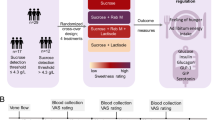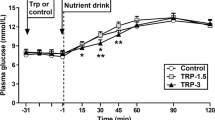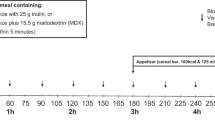Abstract
OBJECTIVES: To investigate mechanisms by which specific sugars affect feeding behaviour.
DESIGN: In an initial study, gastric emptying rate and appetite were measured following ingestion of lemon flavoured solutions of sucrose, maltose (2160 kJ, 575 ml) and water control (67 kJ, 575 ml) given in randomised order on separate days to six male volunteers. In a second study, the effects of intragastric infusions of sucrose and maltose on appetite and gastric emptying were compared in six male volunteers.
RESULTS: When given orally, both the sucrose and maltose solutions slowed gastric emptying compared with water, however sucrose emptied at a faster rate than maltose. The sucrose preload increased fullness and decreased prospective consumption during the following 3 h compared with maltose and water. When administered intragastically, the gastric emptying rate of sucrose was again faster than that of maltose but there was no difference in ratings of hunger, fullness or prospective consumption for 3 h following the infusions.
CONCLUSIONS: These results show that gastric emptying of sucrose is faster than that of maltose and suggest that gastric emptying rate and hence period of gastric distension is not the predominant factor regulating appetite by these sugars. The differences observed between oral and gastric delivery suggest that oro-sensory and cognitive factors, possibly stimulated by the sweetness of sucrose, were involved in the induction of satiety.
This is a preview of subscription content, access via your institution
Access options
Subscribe to this journal
Receive 12 print issues and online access
$259.00 per year
only $21.58 per issue
Buy this article
- Purchase on Springer Link
- Instant access to full article PDF
Prices may be subject to local taxes which are calculated during checkout




Similar content being viewed by others
References
Birch LL, McPhee U, Sullivan S . Children's food intake following drinks sweetened with sucrose or aspartame: time course effects Physiol Behav 1989 45: 387–395.
Booth DA, Campbell AT, Chase A . Temporal bounds of post-ingestive glucose induced satiety in man Nature 1970 228: 1104–1105.
Lavin JH, French SJ, Read NW . The effect of sucrose- and aspartame-sweetened drinks on energy intake, hunger and food choice of female, moderately restrained eaters Int J Obes Relat Metab Disord 1997 21: 37–42.
Rogers PJ, Carlyle J, Hill AJ, Blundell JE . Uncoupling sweet taste and calories: comparison of the effects of glucose and three high intensity sweeteners on hunger and food intake Physiol Behav 1988 43: 547–552.
Black RM, Leiter LA, Anderson GH . Consuming aspartame with and without taste: differential effects on appetite and food intake of young adult males Physiol Behav 1993 53: 459–466.
Blundell JE, Green S, Burley V . Carbohydrates and human appetite Am J Clin Nutr 1994 59(Suppl): 728S–734S.
Foltin RW, Fischman MW, Moran TH, Rolls BJ, Kelly TH . Caloric compensation for lunches varying in fat and carbohydrate content by human in a residential laboratory Am J Clin Nutr 1990 52: 969–980.
Gregory J, Foster J, Tyler H, Wiseman M . The dietary and nutritional survey of British adults HMSO: London 1990.
Blundell JE, Cooling J . The psychobiology of appetite (energy intake). In: Kopelman P (ed). Appetite and obesity: disorders of over- and under-eating. Royal College of Physicians of London: London 1999 9–23.
Read N, French S, Cunningham K . The role of the gut in regulating food intake in man Nutr Rev 1994 52: 1–10.
Elias E, Gibson GJ, Greenwood LF, Hunt IN, Tripp JH . The slowing of gastric emptying by monosaccharides and disaccharides in test meals J Physiol 1968 194: 317–326.
Moran TH, McHugh PR . Distinctions among three sugars in their effects on gastric emptying and satiety Am J Physiol 1981 241: R25–R30.
Gray GM . Carbohydrate absorption and malabsorption. In: Johnson LR (ed). Physiology of the gastrointestinal tract. Raven Press: New York 1981.
Holdsworth CD, Dawson AM . The absorption of monosaccharides in man Clin Sci 1964 27: 371–379.
Levin RJ . Digestion and absorption of carbohydrates—from molecules and membranes to humans Am J Clin Nutr 1994 59(Suppl): 690S–698S.
MacDonald I, Keyser A, Pacy D . Some effects, in man, of varying the load of glucose, sucrose, fructose, or sorbitol on various metabolites in blood Am J Clin Nutr 1978 31: 1305–1311.
Rodin J, Reed D, Jamner L . Metabolic effects of fructose and glucose: implications for food intake Am J Clin Nutr 1988 47: 563–689.
Crapo PA, Kolterman OG, Olefsky JM . Effects of oral fructose in normal, diabetic, and impaired glucose tolerance subjects Diabetes Care 1980 3: 575–581.
Shima K, Suda T, Nishimoto K, Yoshimoto S . Relationship between molecular structures of sugars and their ability to stimulate the release of glucagon-like peptide-1 from canine ileal loops Acta Endocrinol 1990 123: 464–470.
Rodin J . Comparative effects of fructose, aspartame, glucose and water preloads on calorie and macronutrient intake Am J Physiol 1990 51: 428–435.
Spitzer U, Rodin J . Differential effects of fructose and glucose on food intake Appetite 1987 8: 135–145.
Rodin J . Effects of pure sugar vs mixed starch fructose loads on food intake Appetite 1991 17: 213–219.
Guss JL, Kissileff HR, Pi-Sunyer FX . Effects of glucose and fructose solutions on food intake and gastric emptying in nonobese women Am J Physiol 1994 267: R1537–R1544.
Shafer RB, Levine AS, Marlette JM, Morley JE . Effects of xylitol on gastric empting and food intake Am J Clin Nutr 1987 45: 744–747.
Stunkard AJ, Messick S . The three-factor eating questionnaire to measure dietary restraint, disinhibition and hunger J Psychosom Res 1985 29: 71–83.
Collins PJ, Horowitz M, Cook DJ, Harding PE, Shearman DJC . Gastric emptying in normal subjects—a reproducible technique using a single scintillation camera and computer system Gut 1983 24: 1117–1125.
Grundy D . Gastrointestinal motility: the integration of physiological mechanisms. MTP: Lancaster 1985.
Barker GR, Cochrane GM, Corbett GA, Dufton JF, Hunt IN, Roberts SK . Actions of glucose and potassium chloride on osmoreceptors slowing gastric emptying J Physiol 1974 237: 183–186.
Hunt JN, Knox MT . Regulation of gastric emptying. In: Code CF (ed). Handbook of physiology Section 6: Alimentary canal. American Physiological Society: Washington DC 1968 1917–1935.
Brener W, Hendrix TR, McHugh PR . Regulation of gastric emptying of glucose Gastroenterology 1983 58: 76–82.
McHugh PR, Moran TH . Calories and gastric emptying: a regulatory capacity with implications for feeding Am J Physiol 1979 236: R254–R260.
McHugh PR, Moran TH, Wirth JB . Post-pyloric regulation of gastric emptying in rhesus monkeys Am J Physiol 1982 243: R408–R415.
Warwick ZS, Hall WG, Pappas TN, Schiffman SS . Taste and smell sensations enhance the satiating effect of both a high-carbohydrate and a high fat meal in humans Physiol Behav 1993 53: 553–563.
de Graaf C, Hulshof T, Jas P . Short-term effects of different amounts of protein, fats and carbohydrates on satiety Am J Clin Nutr 1992 55: 33–38.
Poothullil JM . Oral satiation and the regulation of intake Physiol Behav 1995 57: 349–352.
Cecil JE, Francis J, Read NW . Relative contributions of intestinal, gastric, oro-sensory influences and information to changes in appetite induced by the same liquid meal Appetite 1998 31: 377–390.
Feldman M, Richardson CT . Role of thought, sight, smell, and taste of food in the cephalic phase of gastric acid secretion in humans Gastroenterology 1986 90: 428–433.
Helman CA . Chewing gum is as effective as food in stimulating cephalic phase gastric secretion Am J Gastroenterol 1988 83: 640–642.
Teff KL, Engelman K . Oral sensory stimulation improves glucose tolerance in humans: effects on insulin, C-peptide and glucagon Am J Physiol 1996 270: R1371–R1379.
Teff KL, Levin B, Engelman K . Oral sensory stimulation in men: effects on insulin, C-peptide, and catecholamines Am J Physiol 1993 265: R1223–R1230.
Wisen O, Bjorvell H, Cantor P, Johansson C, Theodorsson E . Plasma concentration of regulatory peptides in obesity following modified sham feeding (MSF) and a liquid test meal Regul Pept 1992 39: 43–54.
Coutrate TP . Flavours. In: Food. The chemistry of its components. The Royal Society of Chemistry: Cambridge 1996 178–207.
de Graaf C, Schreurs A, Blauw YH . Short-term effects of different amounts of sweet and nonsweet carbohydrates on satiety and energy intake Physiol Behav 1993 54: 833–843.
Tordoff MG, Alleva AM . Oral stimulation with aspartame increases hunger Physiol Behav 1990 47: 555–559.
Blundell JE, Rogers PJ . Sweet carbohydrate substitutes (intense sweeteners) and the control of appetite: scientific issues. In: Fernstrom JD, Miller GD (eds) Appetite and body weight regulation: sugar, fat and macronutrient substitutes. CRC Press, Inc: Boca Raton, FL 1994 113–124.
Castiglione KE, Read NW, French SJ . Food intake responses to upper gastrointestinal lipid infusions in humans Physiol Behav 1998 64: 141–145.
French SJ, Conlon CA, Mutuma ST, Arnold M, Read NW, Meijer G, Francis J . The effects of intestinal infusion of long-chain fatty acids on food intake in humans Gastroenterology 2000 119: 943–948.
Geliebter A, Westreich S, Gage D . Gastric distention by balloon and test-meal intake in obese and lean subjects Am J Clin Nutr 1988 48: 592–594.
Acknowledgements
This work was funded by a grant from The Sugar Bureau.
Author information
Authors and Affiliations
Corresponding author
Rights and permissions
About this article
Cite this article
Lavin, J., French, S. & Read, N. Comparison of oral and gastric administration of sucrose and maltose on gastric emptying rate and appetite. Int J Obes 26, 80–86 (2002). https://doi.org/10.1038/sj.ijo.0801828
Received:
Revised:
Accepted:
Published:
Issue Date:
DOI: https://doi.org/10.1038/sj.ijo.0801828
Keywords
This article is cited by
-
Analysis of Complex Absorption After Multiple Dosing: Application to the Interaction Between the P-glycoprotein Substrate Talinolol and Rifampicin
Pharmaceutical Research (2022)
-
Effects of Oral and Gastric Stimulation on Appetite and Energy Intake
Obesity (2012)
-
Effects of appetite, BMI, food form and flavor on mastication: almonds as a test food
European Journal of Clinical Nutrition (2008)
-
Sugars-containing beverages and post-prandial satiety and food intake
International Journal of Obesity (2006)
-
Influence of repeated consumption of beverages containing sucrose or intense sweeteners on food intake
European Journal of Clinical Nutrition (2004)



